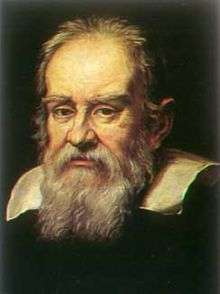Vincenzo Galilei
- This article refers to the father of Galileo Galilei. For Galileo’s son of the same name, see Vincenzo Gamba.

Vincenzo Galilei (c. 1520 – 2 July 1591) was an Italian lutenist, composer, and music theorist, and the father of the famous astronomer and physicist Galileo Galilei and of the lute virtuoso and composer Michelagnolo Galilei. He was a seminal figure in the musical life of the late Renaissance and contributed significantly to the musical revolution which demarcates the beginning of the Baroque era.
Vincenzo, in his study of pitch and string tension, produced perhaps the first non-linear mathematical description of a natural phenomenon known to history.[1] It was an extension of a Pythagorean tradition but went beyond it. Many scholars credit him with directing the activity of his son away from pure, abstract mathematics and towards experimentation using mathematical quantitative description of the results, a direction of utmost importance for the history of physics and natural science in general.
Biography
He was born around 1520 in Santa Maria a Monte (Tuscany),[2] and began studying the lute at an early age. Sometime before 1562 he moved to Pisa, where he married into a noble family. In 1564 Galileo was born, the first of his either six or seven children; another son, Michelagnolo, born in 1575,[3] who also became an accomplished lutenist and composer.
Vincenzo was a skilled player of the lute, and early in life attracted the attention of powerful, well-connected patrons. In 1563 he met Gioseffo Zarlino, the most important music theorist of the sixteenth century, in Venice, and began studying with him.[4] Somewhat later he became interested in the attempts to revive ancient Greek music and drama, by way of his association with the Florentine Camerata[5] (a group of poets, musicians and intellectuals led by Count Giovanni de' Bardi) as well as his contacts with Girolamo Mei,[6] the foremost scholar of the time of ancient Greek music. Sometime in the 1570s his interests in music theory, as well as his composition, began to move in this direction. Some of Galilei's most important theoretical contributions involve the treatment of dissonance: he had a largely modern conception, allowing passing dissonance "if the voices flow smoothly" as well as on-the-beat dissonance, such as suspensions, which he called "essential dissonance." This describes Baroque practice, especially as he defines rules for resolution of suspensions by a preliminary leap away from, followed by a return to, the expected note of resolution.
The use of recitative in opera is widely attributed to Galilei, since he was one of the inventors of monody, the musical style closest to recitative.
Galilei composed two books of madrigals, as well as music for lute, and a considerable quantity of music for voice and lute; this latter category is considered to be his most important contribution as it anticipated in many ways the style of the early Baroque.
Acoustics
Vincenzo Galilei was one of the pioneers in the systematic study of acoustics, mainly in his research (assisted by his son Galileo) in the mathematical formula of stretched strings. Galileo told his biographer that Vincenzo introduced him to the idea of systematic testing and measurement through their Piza house basement which was strung with lengths of lute string materials, each of different lengths, with different weights attached.
Vincenzo made some substantial discoveries in acoustics, particularly involving the physics of vibrating strings and columns of air. He discovered that while the ratio of an interval is proportional to string lengths [for example, a perfect fifth has the proportions of 3:2] it varied with the square root of the tension applied (and the cube root of concave volumes of air). In the case of strings tuned in a perfect fifth, weights suspended from them needed to be in a ratio of 9:4 to produce the 3:2 perfect fifth.[7]
This work was taken further by Marin Mersenne who formulated the current law of vibrating strings. Mersenne was a regular correspondent to many scientists and, after the death of Vincenzo he maintained a regular link to Galileo, and treated him as a prized member of his scientific network. He communicated Galileo's ideas for a pendulum clock to Christiaan Huygens (who improved on it).
Despite being a priest, Mersenne defended Galileo when he came under attack by the church in 1633, but he also questioned Galielo's claims and disputed the accuracy of some of Galileo's findings. He conducted his own duplicate experiments which improved on their accuracy.[8]
References
- ↑ Cohen, H. F. (1984). Quantifying Music: The Science of Music at. Springer. pp. 78–84. ISBN 90-277-1637-4.
- ↑ brunelleschi.imss.fi.it website [Retrieved 2011-12-02] copyrighted to museogalileo.it(Museo Galileo)
- ↑ Fabris, D. © Copyright 1988 - 2011 - Astronomical Society of the Pacific aspbooks.org website article citing Vincenzo Viviani [Retrieved 2011-12-02] originally located at adsabs.harvard.edu website
- ↑ galileo.rice.edu Retrieved 2011-12-02
- ↑ Alfred Einstein Oxford journals article extract [Retrieved 2011-12-02] doi:10.1093/ml/XVIII.4.360
- ↑ image of letter written by G.Mei Retrieved 2011-12-01
- ↑ Palisca, Grove online
- ↑ Encyclopedia.com (Mersenne)
Sources
- Claude Palisca: "Vincenzo Galilei", Grove Music Online, ed. L. Macy (Accessed March 7, 2007), (subscription access)
- Article Vincenzo Galilei, in The New Grove Dictionary of Music and Musicians, ed. Stanley Sadie. 20 vol. London, Macmillan Publishers Ltd., 1980. ISBN 1-56159-174-2 [Retrieved 2004-05-27]
- [see also: galileo.rice.edu Retrieved 2011-12-01]
- Gustave Reese, Music in the Renaissance. New York, W.W. Norton & Co., 1954. ISBN 0-393-09530-4
- The Concise Edition of Baker's Biographical Dictionary of Musicians, 8th ed. Revised by Nicolas Slonimsky. New York, Schirmer Books, 1993. ISBN 0-02-872416-X [Retrieved 2004-05-27]
External links
- Free scores by Vincenzo Galilei at the International Music Score Library Project
- Free scores by Vincenzo Galilei in the Choral Public Domain Library (ChoralWiki)
- Free scores at the Mutopia Project
- Books by Vincenzo Galilei
- Dialogo di Vincentio Galilei ... della musica antica, et della moderna (published by Giorgio Marescotti, 1581)
- Fronimo Dialogo
